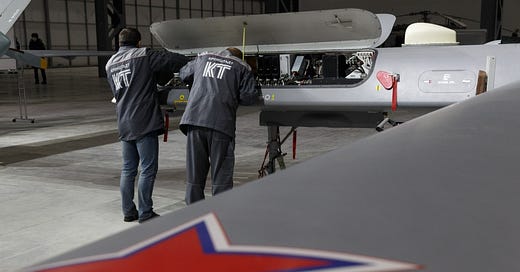(Source: Ministry of Defense of the Russian Federation)
Executive Summary:
Russia's industrial sector faces challenges due to Western sanctions. China emerges as a crucial supplier, providing over 90% of metalworking machine tools and critical parts
Moscow's inability to achieve import substitution in the machine tool industry is exacerbated by sanctions, cutting off access to traditional suppliers, highlighting Russia's vulnerability and dependence on Beijing.
Russia's industrial sector, lacking alternatives, has become entirely reliant on China, signaling a new era in Russian-Chinese relations with Beijing holding a dominant negotiating position.
For years, Russia’s industrial sector has been dependent on imported machine tools, despite the many import substitution programs. Depending on the economic sector, Russia has had to import from 70 to 90 percent of machine tools and their parts (HSE.ru, November 7, 2020; Indpages.ru, March 2, 2023; RG.ru, April 12, 2023; Mashnews.ru, August 23, 2023). At the end of 2020, Moscow openly recognized that Russia will be incapable of realizing its import substitution efforts in the machine tool industry and needs to increase the domestic production of critical machine tools and localize production (Government.ru, November 5, 2020). Moscow’s war against Ukraine and stringent Western sanctions have served to further compound this problem (see EDM, December 4). Currently, sanctions prevent Russian access to its traditional suppliers of advanced metalworking machine tools from Germany, Italy, Japan, Taiwan, South Korea, Switzerland, and the United States. Being unable to produce the necessary machine tools needed for arms manufacturing, Russia turned to China and, in 2023, became fully dependent on Beijing. The heightened level of dependency has inevitably converted into Russia’s growing weakness and vulnerability in its relationship with China.
The domestic share of Russia’s metalworking industry has fallen steadily in recent years. The Russian market of metalworking machine tools was 82.4 billion rubles ($1.2 billion) of the 120–130 billion rubles ($1.75–1.9 billion) total machine tool market in 2022. The share of imported parts in the metalworking market was at least 50 percent. This number, however, did not cover imported parts used for the maintenance of existing machine tools as it did for formally Russian-made machine tools, likely underestimating the share of imports (Stanki-expo.ru, March 16, 2023; RG.ru, April 12, 2023; Mashnews.ru, May 24, 2023).
Within this context, the available statistics of the Chinese General Administration of Customs can be used to estimate China’s share of the Russian market. Particular focus is given to the specific categories of goods exported to Russia that cover metalworking machine tools (Stats.customs.gov.cn, accessed January 21, 2023):
Machine tools working any material by laser or other light or photon beam, water-jet cutting machines, and ultrasonic, electro-discharge, electro-chemical, electron beam, ionic-beam, or plasma arc processes (Code 8456);
Machining centers, unit construction machines (single station), and multi-station transfer machines for working metal (Code 8457);
Lathes for removing metal, horizontal, numerically controlled (Code 845811); and
Lathes for removing metal, numerically controlled, other than horizontal lathes (Code 845891).
The table below displays the value of Chinese metalworking machine tools exported to Russia between 2017 and 2023 according to the General Administration of Customs. The table clearly shows the steady growth of Chinese exports, accelerating significantly in 2022 and 2023.
If we compare these numbers with available UN statistics of machine tool imports in Russia (complete national statistics on imports has not been available since March 2022), the picture China’s central role in the Russian market becomes more clear (Comtradeplus.un.org, accessed January 21, 2023):
From the data above, it is clear that China’s share of Russian imports of metalworking machine tools grew from almost 13 percent in 2017 to 28 percent in 2021. Beijing’s share then jumped to nearly 60 percent in 2022 and approximately 90 percent in 2023. As full data on Russian imports for 2023 is not yet publicly available, China’s share of Russia’s 2023 imports was likely even higher. In 2023, supplies from China completely replaced imports from Europe, the United States, South Korea, and Taiwan.
The same is true for critical parts of metalworking machine tools. These include parts and accessories suited for use principally with machines under codes 8456 and 8465:
Tool holders and self-opening die heads (Code 846610),
Work holders (Code 846620), and
Dividing heads and other special attachments for machines (code 846630).
According to the General Administration of Customs, China’s exports of machine tool parts to Russia have mostly increased since 2017, with a massive spike in 2023. That jump is likely due to a tightening of Western sanctions that prevented Moscow from circumventing certain measures.
Based on the UN statistics on total Russian imports of machine tool parts, China’s share grew from 13 percent in 2017 to 18.4 percent in 2021. After the full-scale invasion of Ukraine, that ratio jumped to 32 percent in 2022 and to between 80 and 90 percent, if not more, in 2023. Even at first glance, the data reveals that Russia’s dependence on China has reached an alarming level with little prospect of diminishing as the war in Ukraine rages on. A significant problem for the Russian industrial sector is the lack of space to diversify machine tool imports for 2024 and beyond.
Russia’s industrial sector has become totally dependent on China. The quality and specifications of Chinese-made machine tools remain an open question. It is unclear whether these machine tools can actually replace the highly sophisticated parts previously imported from Germany and Japan. Nevertheless, this reality marks a new era in Russian-Chinese relations in which Beijing firmly holds the dominant position in negotiations with Moscow.
This article was originally published in Eurasia Daily Monitor. Check it out here!
Pavel Luzin is a visiting scholar at the Fletcher School of Law and Diplomacy, Tufts University. He is also a regular contributor at The Jamestown Foundation. He is a specialist in international relations and an expert on the Russian Armed Forces. Much of his research and writings focus on Russian foreign policy and defense, space policy and non-proliferation studies.







